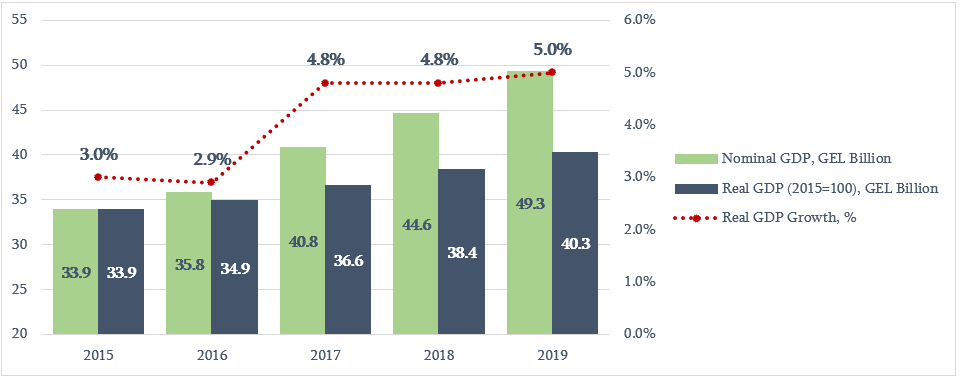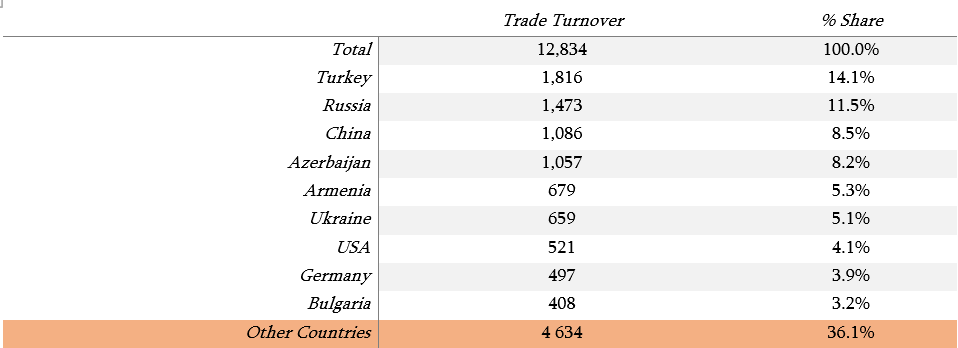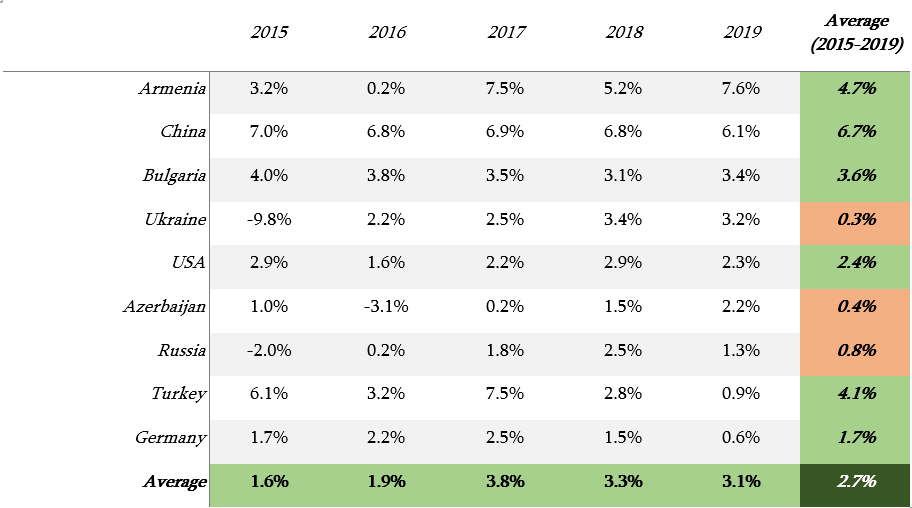Resume: In 2015-2019, Georgia’s average economic growth rate was 4.1% whilst it constituted 4.9% in 2017-2019%. In the last five years, Georgia had a 5% economic growth rate only once in 2019; it was close to this figure in 2017-2018 (4.8% economic growth rate) whilst the economy only grew by 3% and 2.9% in 2015 and 2016, respectively. In this aspect, Ivane Machavariani’s statement is incorrect.
At the same time, the Minister of Finance says a 5% economic growth rate is a “good” figure which is a subjective assessment. Although Georgia had a relatively higher economic growth rate in the last years as well as better economic growth forecasts as compared to neighbour and trade partner countries, the existing figures are insufficient for a substantial economic progress. The current economic growth rate is very little for a developing country and it will take decades to catch up even with the least developed European country. At the same time, in the recent past Armenia and Turkey from Georgia’s neighbour countries achieved 7.5% economic growth rates for certain years. Georgia has not been able to achieve this result in the past years.
In accordance with the data of the National Statistics Office of Georgia, Georgia’s top trade partners are Turkey, Azerbaijan, Armenia, Russia, Germany, China, the USA, Ukraine and Bulgaria in terms of trade turnover (sum of export and import) in 2019. Of these countries, only Russia (1.3%), Turkey (0.9%) and Germany (0.5%) had their economic growth rate close to 1%. The average economic growth rate in Georgia’s trade partners in 2019 was 3.1% whilst the immediate neighbour countries had average economic growth rates of 2.9%. In 2015-2019, the economies of Georgia’s trade partners were growing by 2.7% on average whilst the economies of the neighbour countries were increasing by 2.5%. Although these countries had 1% or even less economic growth rates in certain years, the lowest average economic growth rate in Georgia’s partner countries was 1.3% (registered in 2015) in the years 2015-2019. Therefore, Ivane Machavariani’s statement that the economic growth in Georgia’s trade partners is close to 1% is not true. Moreover, many of Georgia’s trade partners are countries which are much more economically developed as compared to Georgia and their economic growth rate is usually lower as compared to those in developing countries.
Analysis
The Minister of Finance of Georgia, Ivane Machavariani, stated: “In the last period, Georgia’s economy was growing by 5% which was a good figure, particularly in light of the close to 1% economic growth rate of our trade partners.” The gross domestic product (GDP) is an internationally accepted indicator of a country’s well-being and reflects the final market value of the goods and services produced within the country for a year. In order to measure real GDP growth, we need to exclude inflation; that is, the price growth effect which can be done by expressing the value of goods and services produced in a certain year in the base year prices. Graph 1 shows the trend of Georgia’s GDP changes.
Graph 1: Georgia’s GDP Change Trend in 2015-2019

Source: National Statistics Office of Georgia
In 2015-2019, Georgia’s average economic growth rate was 4.1% whilst it constituted 4.9% in 2017-2019. Specifically, the country’s economic growth rate was 5% in 2019. The Minister of Finance says that a 5% economic growth rate is a “good” figure which is a subjective assessment. Although Georgia had a comparably higher economic growth rate in the last years as well as better economic growth forecasts as compared to neighbour and trade partner countries, the existing figures are insufficient for a substantial economic advancement. The current economic growth rate is very little for a developing country and it will take decades to catch up with even the least developed European country. At the same time, in the recent past Armenia and Turkey from Georgia’s neighbour countries achieved 7.5% economic growth for certain years. Georgia, however, has not been able to achieve this result in the past years.
In accordance with the data of the National Statistics Office of Georgia, Georgia’s top trade partners are Turkey, Azerbaijan, Armenia, Russia, Germany, China, the USA, Ukraine and Bulgaria in terms of trade turnover (sum of export and import) in 2019.
Table 1: Georgia’s Trade Partners in Terms of Trade Turnover, 2019, USD Million

Source: National Statistics Office of Georgia
Of Georgia’s trade partners only Russia (1.3%), Turkey (0.9%) and Germany (0.5%) had their economic growth rate close to 1%. The average economic growth rate in Georgia’s trade partners was 3.1% in 2019 whilst in the immediate neighbour countries it was 2.9%. In 2015-2019, the economies of Georgia’s trade partners were growing by 2.7% on average whilst the economies of the neighbour countries were increasing by 2.5%.
Table 2: Economic Growth Rates of Georgia’s Top Trade Partners in 2015-2019, Percentage Figure

Source: World Bank
Although these countries had 1% or even less economic growth rates in certain years, the lowest average economic growth rate in Georgia’s partner countries was 1.3% (registered in 2015) in 2015-2019. Table 2 shows the annual economic growth rates of Georgia’s trade partners.








